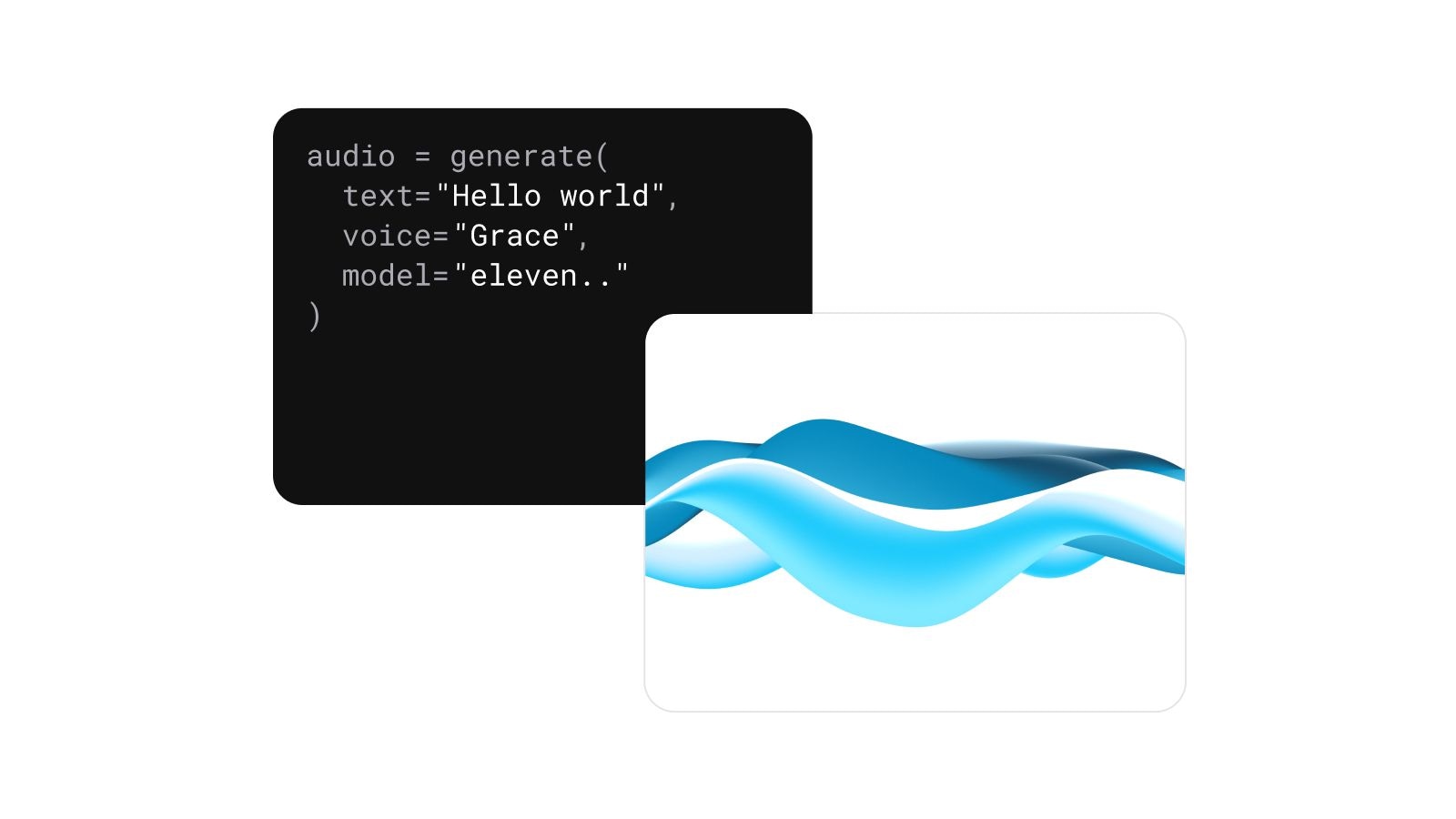
Notre API de synthèse vocale a une faible latence et s’intègre facilement. Un effort de codage minimal suffit à mettre des voix nettes et de haute qualité dans vos applications.
Votre guide pour créer des agents conversationnels réalistes
La technologie vocale transforme notre interaction avec les machines, rendant les outils alimentés par l'IA plus intuitifs et accessibles. Combiner l'IA conversationnelle avec des capacités avancées de text to speech (TTS) pousse ces développements un pas plus loin, permettant aux agents de fournir des réponses claires et humaines.
Python se distingue comme un langage de programmation de choix pour le développement d'IA conversationnelle grâce à sa simplicité et ses fonctionnalités fiables. Associé à une API TTS de haute qualité comme celle d'ElevenLabs, Python permet de créer des agents conversationnels qui comprennent les entrées des utilisateurs et répondent de manière réaliste, presque indiscernable de la parole humaine naturelle.
Ce blog explore pourquoi l'intégration de TTS est importante, les outils nécessaires pour y parvenir, et comment vous pouvez créer votre propre application d'IA conversationnelle en utilisant Python et l'API TTS d'ElevenLabs.
La technologie text to speech amène les applications d'IA conversationnelle à un niveau supérieur en leur permettant de communiquer naturellement avec les utilisateurs. Il ne s'agit plus seulement de comprendre et de traiter le texte, mais de créer des conversations engageantes et pertinentes qui semblent personnelles et humaines.
L'IA conversationnelle alimentée par TTS excelle dans plusieurs domaines. Pour commencer, elle améliore considérablement l'expérience utilisateur en rendant les interactions plus engageantes. Une réponse vocale réaliste peut transformer une interaction de routine, comme vérifier votre solde bancaire, en une expérience positive et agréable.
Un autre avantage clé est une meilleure accessibilité. La technologie TTS garantit que personne n'est exclu de la conversation en permettant aux utilisateurs malvoyants ou ayant des difficultés de lecture d'interagir avec les agents IA.
Au-delà de l'accessibilité, le TTS ouvre également des opportunités pour la communication mondiale. La sortie vocale multilingue permet aux applications IA de s'adresser à des publics divers, en parlant dans leur langue ou accent préféré.
Pour créer un agent d'IA conversationnelle avec TTS, vous devrez assembler les bons outils et bibliothèques.
Python est un point de départ idéal grâce à son vaste écosystème de bibliothèques et sa simplicité. Des bibliothèques comme NLTK sont largement utilisées pour le traitement du langage naturel, tandis que SpeechRecognition gère efficacement la conversion de la voix en texte.
Pour la fonctionnalité text to speech, l'API TTS d'ElevenLabs est un choix remarquable pour les débutants comme pour les professionnels. Ses voix hyper-réalistes, les capacités de voice cloning, et les options de personnalisation garantissent que votre IA conversationnelle soit aussi engageante que fonctionnelle.
Setting up these tools will form the foundation of your project.

Notre API de synthèse vocale a une faible latence et s’intègre facilement. Un effort de codage minimal suffit à mettre des voix nettes et de haute qualité dans vos applications.

Now that we’ve covered the advantages of merging conversational AI and text to speech technology, it’s time to get down to business.
Follow the steps below to power up your conversational AI agent with ElevenLabs TTS:
Start by incorporating ElevenLabs’ TTS API into your project. The platform offers detailed documentation, making it easy to connect the API to your Python application. From generating API keys to testing initial responses, this step establishes the core process of converting text into audio.
Use Python’s SpeechRecognition library to capture user speech and convert it into text. This step enables two-way interaction, with users speaking their queries instead of typing. Combine this functionality with NLTK to analyze the text inputs and ensure your AI understands user intent.
Once the AI has interpreted user input, send the response text to ElevenLabs’ TTS API to generate a spoken reply. The API’s customization features allow you to fine-tune the voice to suit the tone and personality of your application, whether professional, friendly, or authoritative.
Thorough testing is essential to ensure your conversational AI performs well in various scenarios. Test the latency of audio responses, the accuracy of user input interpretation, and the overall flow of conversations. Gather user feedback to identify areas for improvement and adjust settings accordingly.
After refining the application, it’s time to deploy. ElevenLabs’ TTS API is designed to handle high volumes of interactions, making it scalable for small and large projects alike. Whether your application serves a niche audience or an enterprise-level user base, ensure that the deployment environment supports effortless scaling.
Once your conversational AI agent is up and running, focus on optimizing its performance to handle real-world demands. Reducing latency is a key priority. Implementing caching for frequently generated audio can significantly minimize response times. Additionally, ensure that your application is equipped to support multilingual interactions, a must-have feature for reaching global audiences.
Une fois que votre
Integrating text to speech with conversational AI closes the gap between technology and human interaction, offering more lifelike user experiences. With Python’s developer-friendly features and ElevenLabs’ advanced TTS API, creating voice-driven applications has never been simpler.
Whether you’re building a chatbot for customer support, an educational virtual assistant, or a multilingual AI agent, the right tools and careful integration make all the difference. By following best practices and making the most of ElevenLabs’ features, you can launch conversational AI agents that deliver top-notch user experiences.

Notre API de synthèse vocale a une faible latence et s’intègre facilement. Un effort de codage minimal suffit à mettre des voix nettes et de haute qualité dans vos applications.

Construire des dialogues d'IA conversationnelle avec un TTS réaliste

Introducing a set of updates that expand what creators and developers can build with Eleven Music.
Propulsé par ElevenLabs Agents